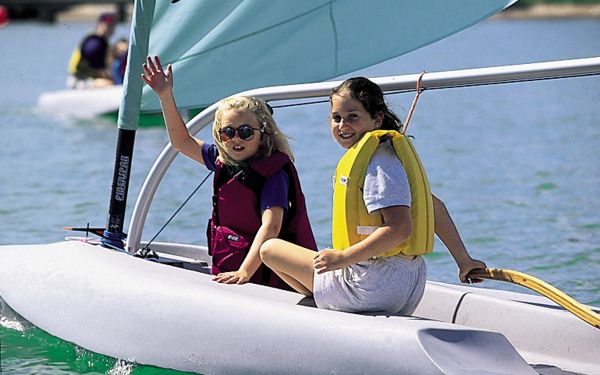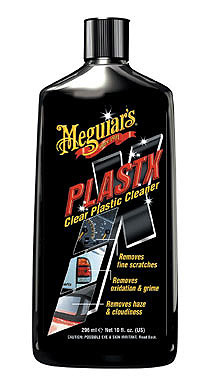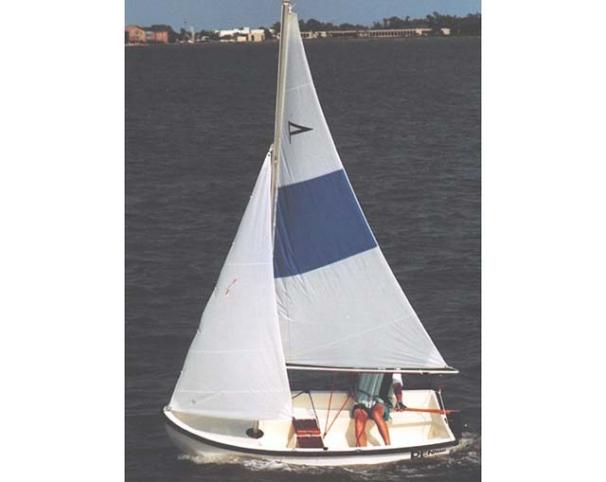Rotomolded Dinghies: Plastic Fantastic
Here comes the indestructible sailboat
 Fifty years ago, when fiberglass was still a newfangled miracle
Fifty years ago, when fiberglass was still a newfangled miracle
material, hardcore wooden boat sailors contemptuously referred to the new
boats as "Clorox bottles." Today, that's never been truer.
The sudden proliferation of "poly" boats — made from polyurethane or polyethylene — has combined with some innovative thinking to create a burgeoning fleet of new dinghies. For sailors familiar with fiberglass (or even wood) boats, poly boats are a new breed.
Rotomolding is a proven process that has been used for years
to produce hollow plastic items ranging from automobile parts to simple
outboard fuel tanks. Raw plastic granules that look much like B-Bs are
poured into a hollow metal mold, which is then heated to a precise
temperature that melts the plastic. The mold is rotated around three axes
in a controlled pattern to thoroughly and evenly coat the inside with the
molten plastic. The mold is cooled and opened, revealing a perfectly
finished hull.
One problem with conventional rotomolding was that there was little
stiffness in the material, which was fine for small fuel cans but not good
for boats. Some boats, like the Escapes, solve the problem with stiffening
ribs (that also serve as protection for the hull) and hard corners that add
rigidity.
A second solution came with the introduction of a semi-rigid foam
material that could also be rotomolded, and this is the method used on the
Laser Pico. After the poly outer skin is formed in the mold, a second
rotation with the low density foam adds thickness, and a final rotation
with another poly layer completes the sandwich hull.
Let's look at some of these new poly daysailers.
Escape
First on the scene was Escape Sailboats which, as a spin-off from
the company building the Laser and Sunfish, set out to create a dinghy that
would be stable, durable, inexpensive and have self-teaching capabilities.
Designed by Garry Hoyt, the Escape 11.5 began production in 1996 and
quickly became the best selling sailboat in North America and, now called
the Captiva, in the world. Escapes are made in one piece of polyurethane
or polyethylene and tales are told of Escapes being used as toboggans on
rock-strewn ski slopes and suffering only scuffs.
The company now builds six different models ranging from 7 feet up
to 13 feet ($699 to $2,399), and all are models of innovation. The
Stableform hull shape puts the widest part of the boat in the water, so you sit
within the "foot print;" the Autosail allows beginners to match the boom
position to the wind indicator; SimpleRig is a windsurf-like sail with a
sprit; and SmartRig is a patented plan that mounts the boom at a fixed
height and allows the mast to roll the sail up easily.
Laser
Once the most popular dinghy in the world, the Laser people were
determined to produce a boat that would make sailing easily accessible and
they may well have achieved that goal. Adopted worldwide by sailing
schools, the 11-foot-6-inch Pico is made from high-density Tecrothene, with the
previously described core of low density material. Easily repaired, the
hull has built-in flotation and is highly resistant to scratching and
fading.
The cockpit is rounded, with space for two and a single hiking
strap, while the rudder pushes and locks into place with the tiller. The
standard Pico has a 64-square-foot mainsail with a high boom ($2,275), while the
Pico Plus has a 12-square-foot jib, and the all-up weight of the boat is just
131 pounds.
DeWitt Dinghy
Newest contender in the poly wars is the DeWitt dinghy. Like
the Escapes, it is bright yellow and rotomolded. Designed by long-time El
Toro sailor Jim DeWitt, it bears more than a passing resemblance to that
pram and holds two adults comfortably. At 8 feet 6 inches and with a weight of 90 pounds, the DeWitt comes with a carbon fiber mast, Mylar sails and built-in
seating.
Durable and easy to maintain, it comes in a simply rigged Resort
model ($2,395), a Sport model with more adjustments and a roller
furling mainsail ($2,695), and a Competition model ($3,295) with fully-battened main.












